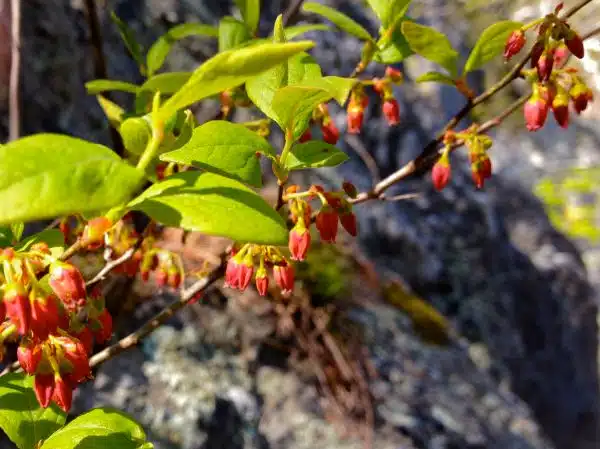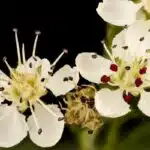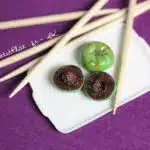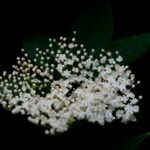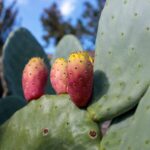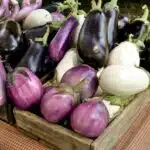Black huckleberries, scientifically known as Gaylussacia baccata, are a delightful treat for those with a sweet tooth. These small fruits are native to North America and are often found in the wild, but they can also be grown in gardens with proper care. In this article, we will discuss how to grow and care for black huckleberries.
Growing black huckleberries requires patience and attention to detail, but the rewards are worth it. Not only do these berries taste delicious on their own or added to desserts, but they are also packed with antioxidants and other beneficial nutrients. By following the tips outlined in this article, you can cultivate healthy black huckleberry plants that will provide you with a bountiful harvest year after year. Whether you are an experienced gardener or just starting out, there is something to be learned about growing and caring for black huckleberries.
Understanding The Black Huckleberry Plant
The black huckleberry plant, also known as Gaylussacia baccata, is a small shrub that belongs to the heath family. This plant is native to North America and commonly grows in acidic soil regions. It can grow up to six feet tall, producing blue-black berries during summer that are edible and tasty. The leaves of this plant are oval-shaped with a glossy upper surface and a pale green lower surface.
Black huckleberry plant anatomy includes several distinct features. Its stem is woody and branched, while its roots are shallow but wide-spreading. The flowers of the black huckleberry look like little white bells, which eventually turn into berries after pollination by bees or other insects. These fruits are small and round, measuring about 6mm in diameter.
There are several varieties of black huckleberries that gardeners can identify using their physical properties. These include plants with different leaf colors such as yellow-green or blue-green hues. Some varieties have larger berries than others, while others produce more fruit overall. By understanding these differences, gardeners can select the right variety for their desired outcome in terms of taste preference or yield potential. Moving on to choosing the right location for your black huckleberry plants…
Choosing The Right Location For Your Black Huckleberry Plants
When it comes to growing black huckleberries, choosing the right location is crucial. These plants require a specific set of environmental conditions in order to thrive and produce healthy fruit. The following factors should be taken into consideration when selecting a location for your black huckleberry plants.
Firstly, sunlight exposure is an essential consideration when selecting a location for your black huckleberry plants. These plants require full sun or partial shade to grow successfully. Therefore, you should select a spot that receives at least six hours of direct sunlight each day. If you are planting in an area with hot summers, it may be best to choose a location that offers some afternoon shade.
Secondly, soil preparation plays a significant role in the growth and development of black huckleberries. These plants prefer acidic soil with a pH range between 4.5 and 5.5. It is recommended that you test the soil before planting to ensure it meets these requirements. Additionally, ensure the soil is well-drained as black huckleberries do not tolerate wet feet.
Finally, when selecting a site for your black huckleberry plants consider access to water sources as these plants require consistent moisture throughout their growing season. It may be beneficial to locate them near natural water sources such as streams or ponds or plan on providing irrigation if necessary.
- Select an area with at least six hours of direct sunlight per day.
- Ensure the soil pH ranges from 4.5 to 5.5.
- Choose a location with access to consistent water sources.
The next step in successfully growing and caring for your black huckleberries is preparing the soil for planting.
Preparing The Soil For Planting
Soil preparation is crucial when it comes to growing black huckleberries. These plants thrive in acidic soil with a pH between 4.0 and 5.5, so it’s important to test the soil before planting. If the soil is not acidic enough, you can lower the pH by adding sulfur or other acidifying agents. Once the soil is at the right pH level, it’s time to prepare it for planting.
The first step in preparing your soil is to remove any weeds or debris from the area where you plan to plant your black huckleberries. This will give your plants a clean slate to grow on and prevent competition for nutrients. Next, you should loosen the soil using a garden fork or tiller. This will allow air and water to penetrate more easily and promote healthy root growth.
Finally, you should amend the soil with organic matter such as compost, peat moss, or aged manure. Black huckleberries require well-draining soil that is rich in organic matter and nutrients such as nitrogen, phosphorus, and potassium. By amending your soil with these organic materials, you’ll ensure that your plants have all the nutrients they need to thrive.
Moving forward into propagating black huckleberries requires careful attention to detail in order to achieve success.
Propagating Black Huckleberries
Black Huckleberries can be propagated through cuttings. These should be taken from disease-free, mature plants and planted in moist, well-drained soil.
Pruning should be done in late winter or early spring while the plants are dormant. Proper pruning will result in a dense, well-shaped bush.
Fertilizing should be done with a high-nitrogen fertilizer in early spring and repeated every few months to help the plants grow.
Watering is critical for Black Huckleberries; they should be watered every few days during periods of drought.
For optimal results, a layer of mulch should be used to help retain moisture and keep the soil cool.
When propagating Black Huckleberries, it is important to remember that proper care is necessary to ensure healthy growth and a bountiful harvest.
Planting Cuttings
In propagating Black Huckleberries, one of the most effective propagation techniques is through planting cuttings. This method allows for the production of genetically identical plants to the parent plant, ensuring consistency in fruit quality and yield. Prior to taking cuttings, it is important to ensure that the parent plant is healthy and disease-free.
To begin planting cuttings, select a healthy branch from the parent plant that is approximately 6-8 inches long with several leaves attached. Remove any leaves on the lower half of the cutting and dip it in rooting hormone to promote root growth. Prepare a potting mix by combining peat moss and perlite in a 1:1 ratio, moisten it lightly, and fill a pot with this mixture. Insert the cutting into the potting mix up to its leafless portion and water well.
For optimal success when planting cuttings, maintain a high level of humidity around them by enclosing them within a clear plastic bag or placing them in a humid environment. Avoid direct sunlight as this may cause excessive heat build-up within the enclosure which could damage or kill the cuttings. After about 4-6 weeks, check for signs of new growth as an indication that rooting has occurred. Once rooted, transplant each cutting into individual pots containing suitable soil mixtures and continue caring for them until they are strong enough to be planted outdoors.
Planting cuttings offers an efficient way of propagating Black Huckleberries while maintaining genetic consistency with parent plants. Rooting hormone can help speed up this process by promoting root growth. By following proper care instructions such as maintaining high humidity levels and providing consistent watering, successful propagation can be achieved even by those without prior horticulture experience.
Pruning And Fertilizing
In addition to planting cuttings, there are other important practices to consider when propagating Black Huckleberries. Pruning and fertilizing are two key techniques that can help ensure the plant’s health and maximize yield. When it comes to pruning, it is essential to remove dead or diseased branches regularly, as these can spread infections and reduce fruit quality. Additionally, pruning can stimulate new growth and promote a more balanced plant structure.
When it comes to fertilizing Black Huckleberries, there are several types of fertilizers to consider. Organic options such as compost or aged manure can provide slow-release nutrients over time, while synthetic options like granular fertilizers can offer a more immediate boost. It is important to select a fertilizer with appropriate levels of nitrogen, phosphorus, and potassium – or NPK – based on the plant’s needs. Additionally, applying fertilizer at the right time of year – typically in early spring before flowering – can help ensure optimal growth.
By incorporating proper pruning and fertilization techniques into their propagation practices, growers can help ensure healthy plants and bountiful harvests. Whether using organic or synthetic fertilizers, selecting appropriate NPK levels is crucial for success. Regularly removing dead or diseased branches through pruning can also help protect against disease and promote new growth.
Watering And Mulching
As a horticulture expert, it is crucial to consider proper watering and mulching techniques when propagating Black Huckleberries. These practices not only ensure the plant’s health but also maximize yield. Watering is essential for the plant’s growth, and providing enough water at the right time can make all the difference in its survival. It is important to keep the soil moist but not waterlogged to avoid root rot. Proper watering techniques include regular watering during dry spells, avoiding overhead watering that can damage leaves, and providing sufficient drainage.
Mulching is equally important when propagating Black Huckleberries. Mulch helps retain moisture in the soil and suppress weeds while regulating soil temperature. The importance of mulching cannot be overstated as it also provides a protective layer for delicate roots against extreme temperatures during winter or summer months. Moreover, mulching with organic materials such as pine needles, wood chips or bark can provide additional nutrients to the soil over time.
Incorporating proper watering and mulching techniques into propagation practices will help ensure healthy plants and maximum yield. Providing appropriate amounts of water at right intervals will encourage deeper root growth allowing for greater nutrient uptake from the soil. Mulching with organic materials helps protect against extreme temperatures while suppressing weed growth – this ultimately leads to less competition for resources between competing plants while ensuring that black huckleberries continue thriving over time.
Planting Black Huckleberries
Are you looking to plant black huckleberries in your garden? Before getting started, it’s important to consider a few factors. First, choosing the right container is essential for the growth of the plant. Opt for a container that is at least 18 inches wide and 12 inches deep, with drainage holes to prevent waterlogging. Secondly, timing is crucial when planting black huckleberries. The best time to plant them is in early spring or late fall when the soil is moist.
To ensure your black huckleberry plant thrives, there are several maintenance tips you should keep in mind. Firstly, provide adequate sunlight by placing the container in an area with at least six hours of direct sunlight daily. Secondly, fertilize once every two weeks from late spring to early summer using a balanced fertilizer. Additionally, watering should be done regularly but not too frequently as this can cause root rot.
Common mistakes made when growing black huckleberries include planting them in containers that are too small and failing to provide proper drainage. Over-fertilization can also lead to salt buildup in the soil which can burn the roots of the plant. In addition, avoid overwatering as this can lead to root rot and fungal diseases.
As important as planting and maintaining your black huckleberry plants may be, watering them correctly is equally essential for their growth and overall health. So how do you do it? Keep reading to find out!
Watering Black Huckleberries
- Black huckleberries require consistent, moderate amounts of water and soil moisture for proper growth and fruiting.
- Irrigation should be provided during dry periods to ensure the soil is kept moist but not soggy.
- Inconsistent or excessive amounts of water can damage the plant and reduce the yield of fruit.
- By monitoring soil moisture levels and watering as needed, growers can anticipate good harvests of this delicious and nutritious berry.
Water Requirements
Black huckleberries are a prized fruit with many health benefits. To ensure a successful crop, it is important to provide adequate water for the plants. Rainwater harvesting is an excellent way to irrigate black huckleberries naturally. Collecting rainwater in barrels or other containers can help reduce water usage and provide plants with the necessary moisture they need to thrive.
Drip irrigation systems are also an effective method of watering black huckleberries. This system delivers water directly to the roots of the plants, reducing evaporation and ensuring that each plant receives the appropriate amount of water. Drip irrigation systems can be customized to meet specific plant needs, making them an efficient watering option for black huckleberries.
It is essential not to overwater black huckleberries as they prefer well-draining soil. Waterlogged soil can lead to root rot, stunted growth, and fungal diseases. Therefore, it’s imperative to monitor soil moisture levels regularly and adjust watering accordingly. By using rainwater harvesting or drip irrigation systems and being mindful of soil moisture levels, gardeners can successfully grow and care for their black huckleberry plants.
Soil Moisture
Maintaining adequate soil moisture is crucial for growing healthy and productive black huckleberries. Soil moisture affects plant growth, fruit quality, and yield. Gardeners must understand the importance of proper watering techniques to prevent under or overhydration of their plants.
One effective way to maintain soil moisture is by using mulching techniques. Mulch acts as a protective layer on top of the soil, reducing evaporation and retaining moisture within the root zone. Organic mulches like wood chips, leaves, or straw can also improve soil structure and nutrient content as they decompose.
In addition to mulching techniques, irrigation systems play a vital role in maintaining optimal soil moisture levels. Drip irrigation systems are ideal for huckleberry plants as they provide water directly to the roots without wetting the foliage. They also reduce water usage by up to 50% compared to traditional sprinkler systems. Monitoring soil moisture levels regularly is essential when using irrigation systems to avoid overwatering or underwatering plants.
By incorporating mulching techniques and efficient irrigation systems into their gardening practices and monitoring soil moisture levels regularly, gardeners can ensure that their black huckleberries receive adequate water while preventing waterlogging or dehydration of their plants’ root system.
Fertilizing Black Huckleberries
Black huckleberries need proper nutrients to grow and produce abundant fruit. Fertilizing is an essential aspect of caring for these plants. Whether you choose organic or synthetic fertilizers, the key is to provide the correct balance of nutrients that will support healthy growth and fruit production.
Organic fertilizers are derived from natural sources such as compost, manure, and bone meal. These fertilizers enhance soil fertility by providing a slow-release source of nutrients that improve soil structure and promote microbial activity. When using organic fertilizers, it’s important to apply them in moderation to avoid overfeeding your plants. Too much fertilizer can lead to excessive vegetative growth and decrease fruit production.
On the other hand, synthetic fertilizers are chemically formulated to provide a quick-release source of nutrients. These fertilizers are easy to use and can be precisely measured for accurate application rates. However, they can also be detrimental to soil health if used excessively or incorrectly. Synthetic fertilizers tend to have high nitrogen content, which can cause rapid vegetative growth at the expense of fruit production. It’s recommended to use synthetic fertilizers sparingly and only when necessary.
| Organic Fertilizer | Synthetic Fertilizer |
|---|---|
| Compost | Ammonium Nitrate |
| Manure | Urea |
| Bone Meal | Potassium Nitrate |
In summary, proper fertilization is crucial for growing healthy black huckleberries with plentiful fruit yields. While both organic and synthetic fertilizers have benefits, it’s important to use them correctly and in moderation. By providing adequate nutrition through proper fertilizer application, your black huckleberries will thrive and produce delicious berries year after year. In the next section on pruning black huckleberries, we’ll discuss how trimming back old growth can further enhance plant health and productivity.
Pruning Black Huckleberries
To ensure that your black huckleberries thrive, it is important to prune them regularly. Pruning involves removing dead or diseased branches, as well as any crossed or rubbing branches that may inhibit growth. The optimal time for pruning is in late winter or early spring, before new growth begins.
When pruning black huckleberries, it is important to use sharp, clean tools to prevent damage and disease spread. Cut the branches at a 45-degree angle just above a bud or branch junction. A general rule of thumb is to remove no more than one-third of the plant’s overall size each year. This allows for healthy growth and fruit production.
Tips for pruning include removing any old wood and cutting away any ground-level shoots that may compete with the main stem. Additionally, thinning out the center of the plant can improve air circulation and sunlight exposure, which can reduce pest and disease problems. With proper pruning techniques and frequency, you can ensure that your black huckleberries are healthy and productive for years to come.
As essential as pruning is for maintaining healthy plants, protecting your black huckleberries from pests and diseases is equally crucial. In the next section, we will explore tips on how to identify common pests and diseases affecting these berries, as well as effective measures you can take to prevent their occurrence.
Protecting Black Huckleberries From Pests And Diseases
Black huckleberries are susceptible to a wide variety of pests and diseases, including fungi, bacteria, and viruses, and it is important to identify the specific pest or disease in order to implement effective control methods.
Prevention is the best approach to protecting black huckleberries from pests and diseases; this can include cultural practices such as providing proper soil drainage, mulching, and avoiding overcrowding.
Chemical control can be used to protect plants from pests; this may include the application of insecticides and fungicides.
It is important to monitor black huckleberry plants for signs of pest or disease infestations; early detection can help to minimize damage to the plants.
When black huckleberry plants become infected, it is important to take prompt action to treat the plants; this may include the use of fungicides, pesticides, or other types of chemical control.
Biological control can also be utilized to manage pest and disease problems in black huckleberry plants; this may involve the use of beneficial insects and other natural predators.
Identifying Pests And Diseases
As a horticulture expert, it is important to identify natural predators that can harm black huckleberries. One common pest that is known to attack the plant is the spotted wing drosophila. This fruit fly lays its eggs on ripening berries, which then hatch into larvae and feed on the fruit. To prevent infestations, cover the plants with fine mesh netting during the growing season or use insecticides specifically designed for this pest.
In addition to pests, black huckleberries are susceptible to a variety of diseases. One common disease is leaf spot, which causes small brown spots on leaves that eventually turn yellow and fall off. To treat leaf spot, remove infected leaves and dispose of them in the trash rather than composting. Additionally, apply a fungicide spray to protect healthy leaves from becoming infected.
Another disease that affects black huckleberries is powdery mildew. This fungal disease appears as a white powdery coating on leaves and stems, which can stunt growth and reduce yield. To treat powdery mildew, apply a fungicide spray when symptoms first appear and continue every 7-14 days until the disease is under control. By identifying natural predators and common diseases along with their treatments, gardeners can successfully protect their black huckleberry plants from pests and diseases without compromising yield or quality.
Protecting Plants From Pests
To ensure a healthy harvest, gardeners must take measures to protect their black huckleberry plants from pests and diseases. One effective method is natural pest control, which involves using natural predators to eliminate harmful insects without the use of harmful chemicals. Ladybugs, lacewings, and praying mantises are just a few examples of natural predators that can be introduced into the garden to control aphids, spider mites, and other pests.
In addition to natural pest control methods, homemade pest repellents can also be used to protect black huckleberry plants from pests. Garlic spray and hot pepper spray are two examples of homemade repellents that can deter insects from feeding on the plants. These repellents are safe for both the plants and the environment and can be easily made at home with common household ingredients.
Despite these preventative measures, some pests may still find their way onto black huckleberry plants. In such cases, it is important to identify the pest quickly and take action before significant damage occurs. Regular scouting of the garden for signs of infestation can help detect pests early on so that appropriate treatments can be applied in a timely manner. By utilizing natural pest control methods, making homemade repellents, and staying vigilant against potential infestations, gardeners can effectively protect their black huckleberry plants from pests without compromising yield or quality.
Treating Infected Plants
Identifying symptoms of pest and disease infestation is crucial in treating infected black huckleberry plants. Gardeners must be familiar with the common symptoms of infestation such as yellowing leaves, wilting, stunted growth, and discoloration. These symptoms can indicate various pests such as aphids, spider mites, and whiteflies or diseases like powdery mildew and leaf spot. Early detection of these symptoms can significantly reduce the damage caused by pests and diseases.
Once symptoms are identified, gardeners can utilize natural remedies to treat infected plants. Neem oil is an effective natural pesticide that can control a wide range of pests without harming beneficial insects. It also has anti-fungal properties that can prevent fungal infections on plants. A solution of baking soda and water can also be used to control fungal infections like powdery mildew. For severe infestations or diseases, gardeners may need to resort to chemical treatments but should do so with caution and follow label instructions.
In addition to applying treatments for infected plants, gardeners should also take measures to prevent further spread of pests and diseases. This includes proper sanitation practices such as removing infected plant debris from the garden area and disinfecting gardening tools between uses. Regular monitoring of plants for signs of infestation is also important in preventing the spread of pests and diseases. By promptly identifying symptoms, utilizing natural remedies, taking preventive measures, gardeners can effectively treat infected black huckleberry plants and protect them from future infestations.
Harvesting Black Huckleberries
As the autumn breeze sets in, the black huckleberry season approaches, and it’s time to harvest these juicy, sweet berries. To ensure a bountiful harvest, it’s important to know the correct techniques for handpicking black huckleberries. These techniques will not only maximize your yield but also prevent damage to the plant and surrounding environment.
To begin, make sure that you are harvesting ripe berries. Look for plump, dark blue/black fruits that come off easily when touched. Berries that are still red or green are not yet ripe and should be left on the bush to mature further. When picking ripe berries, use your fingertips to gently pull them from the stem without disturbing other fruit or branches.
When collecting black huckleberries, avoid using a rake or any other tool that could damage the plant or disturb the soil around it. Instead, use your hands to gently comb through the bush, selecting only fully ripe berries. When done correctly, handpicking is an efficient technique that protects both the plant and its environment.
In preparation for long-term storage of black huckleberries after harvest season ends, proper techniques must be applied during harvesting. The next section will cover how to store these delicious fruits so you can enjoy them throughout the year without spoiling their taste or texture.
Storing Black Huckleberries
After harvesting black huckleberries, it is important to store them properly to ensure their longevity. One way to do this is by freezing the berries. To freeze black huckleberries, first wash them in cold water and remove any stems or debris. Then spread the berries out on a baking sheet and place them in the freezer until they are fully frozen. Once frozen, transfer the berries to airtight containers or freezer bags and store them in the freezer for up to six months.
Another way to preserve black huckleberries is by making jam. Black huckleberry jam is a delicious way to enjoy the fruit all year round. To make jam, start by washing and crushing the berries, then cook them with sugar and lemon juice until they reach a desired consistency. The jam can be stored in sterilized jars for up to a year.
When using frozen black huckleberries in recipes, it is best to thaw them before use. This can be done by placing the frozen berries in the refrigerator overnight or at room temperature for a few hours. Frozen black huckleberries are great for use in smoothies, baked goods like pies and muffins, or as toppings for yogurt or oatmeal.
Next, we will explore some creative ways that black huckleberries can be used in cooking and baking beyond just freezing or making jam.
Using Black Huckleberries In Cooking And Baking
Just as a painter blends and mixes colors to create a masterpiece, so too can you use black huckleberries to add depth and complexity to your culinary creations. Black huckleberry recipes can range from sweet to savory, and their tart yet slightly sweet flavor makes them versatile in the kitchen. Whether you’re making a jam, pie, or adding them to a salad dressing, black huckleberries are sure to elevate any dish.
Not only do black huckleberries add delicious flavor to your dishes, but they also provide numerous health benefits. These little berries are packed with antioxidants that can help reduce inflammation and lower the risk of chronic diseases such as heart disease and cancer. In addition, they are high in fiber which is essential for digestive health.
If you’re looking for some inspiration on how to use black huckleberries in your cooking and baking, there are plenty of recipes available online or in cookbooks. From muffins and pancakes to sauces and marinades, the possibilities are endless. Don’t be afraid to experiment with different flavor combinations – black huckleberries pair well with everything from cinnamon and nutmeg to savory herbs like rosemary and thyme.
As you explore the world of black huckleberry recipes, consider preserving these little treasures for future use. Whether you freeze them or make jam or jelly, preserving black huckleberries will ensure that you have access to their delicious flavor all year round. In the next section, we’ll explore some methods for preserving these tasty berries so that you can enjoy them long after the growing season has ended.
Preserving Black Huckleberries
Black huckleberries are a great source of nutrients and antioxidants that can be enjoyed all year round. Canning and freezing are the two most common ways to preserve black huckleberries. Canning is a process of preserving food in jars by heating them at high temperatures, while freezing is simply storing food in a freezer.
If you prefer canned black huckleberries, wash and sterilize the jars before filling them with berries. Add sugar syrup or water to fill any gaps, leaving about half an inch of headspace. Boil the jars for 15 minutes, then let them cool down. Store the jars in a cool and dark place for up to 12 months.
On the other hand, if you prefer frozen black huckleberries, wash and dry them thoroughly before placing them in an airtight container or freezer bag. It’s recommended to freeze them on a tray first before transferring them to containers to prevent clumping together. Frozen black huckleberries can last up to 6 months.
Markdown list:
- Enjoy the taste of ripe black huckleberries even when they’re out of season.
- Share your love for this delectable berry with family and friends.
- Avoid wasting excess fruit by preserving it.
- Keep your pantry stocked with healthy foods all year round.
To ensure that you always have access to fresh and tasty black huckleberries, take advantage of these preservation techniques. With proper care and storage, you can enjoy this nutritious berry throughout the year without worrying about spoilage or waste.
Transition: Now that we’ve covered how to preserve your black huckleberry harvest, let’s move on to troubleshooting common problems that may arise during cultivation.
Troubleshooting Common Black Huckleberry Problems
Black huckleberries are susceptible to a variety of diseases, such as leaf spots and root rot, so it is important for the horticulturist to be able to identify these problems in order to take the necessary steps to treat them.
Pests can also be a source of problems for black huckleberries, so it is important to ensure that the plants are regularly monitored for signs of infestations.
Once disease or pests have been identified, it is important to take the appropriate steps to treat the problem, such as applying appropriate fungicides or insecticides.
For long-term success with black huckleberries, it is important to practice proper care, including proper watering, fertilizing, and pruning, as these steps can help to prevent or minimize the impact of disease and pests.
Identifying Disease
One of the most common problems that black huckleberry growers face is disease. Identifying disease in the early stages can prevent infections from spreading and causing irreparable damage to your plants. As a horticulture expert, it is important to stay vigilant for signs of disease such as leaf spots, wilting or yellowing leaves, and abnormal growth patterns.
Preventing infections is always better than treating them. To reduce the risk of disease, make sure your black huckleberries are planted in well-draining soil with proper air circulation. Avoid overwatering and overcrowding your plants. Regularly pruning dead or damaged branches can also help to improve air flow and reduce the risk of infection.
If you do identify signs of disease, prompt treatment options are essential to preserve the health and vitality of your plants. Depending on the type of disease, fungicides or bactericides may be effective solutions. However, it is important to consult with a professional before administering any treatments to ensure that you are using safe and effective products for your specific situation.
Treating Pests
In addition to diseases, black huckleberry growers may also face pest problems. Pests such as aphids, spider mites, and fruit worms can cause significant damage to your plants if not addressed promptly. To prevent pest infestations, it is important to maintain a healthy growing environment for your black huckleberries. This includes proper irrigation and fertilization, as well as regular pruning and weeding.
If pests do become an issue, there are both natural remedies and chemical solutions available. Natural remedies such as insecticidal soap or neem oil can be effective against certain pests without harming beneficial insects in the area. However, it is important to note that natural remedies may require multiple applications and may not always be as effective as chemical solutions.
Chemical solutions such as pesticides can be highly effective at controlling pests but should be used with caution. It is essential to choose the right product for your specific pest problem and to follow all instructions carefully to avoid harming your plants or the environment. As with any treatment option, consulting with a professional is recommended before administering any chemicals on your own. By staying vigilant for signs of pest infestations and utilizing appropriate prevention methods and treatment options when necessary, you can ensure the health and productivity of your black huckleberry plants.
Best Practices For Growing And Caring For Black Huckleberries
Have you been experiencing problems with your black huckleberry plants? It is important to address these issues to ensure that your plants grow healthy and productive. However, prevention is always better than cure. In this section, we will discuss the best practices for growing and caring for black huckleberries.
The benefits of black huckleberries are numerous. Not only do they produce delicious fruits that can be used in various recipes, but they are also rich in antioxidants, vitamins, and minerals. Black huckleberries are also hardy plants that can tolerate cold temperatures and drought conditions. These qualities make them an ideal addition to any garden or landscape.
When it comes to caring for black huckleberries, there are a few common mistakes that many people make. One of the most significant errors is overwatering the plants. Black huckleberries prefer well-draining soil and do not require excessive watering. Additionally, pruning is essential to encourage growth and prevent diseases from spreading. Neglecting pruning can lead to weak plant growth and lower fruit production.
By following these best practices for growing and caring for black huckleberries, you can ensure that your plants thrive and produce high-quality fruits. Remember to provide adequate sunlight, water sparingly, fertilize regularly with organic compost or fertilizer, prune annually, and monitor for pests and diseases regularly. With proper care, your black huckleberry plants will provide you with a bountiful harvest year after year!
Conclusion
The Black Huckleberry is a versatile plant that can be grown in a variety of locations and soil types. With proper care and attention, this plant can yield a bountiful harvest of delicious berries that can be used in cooking, baking, and preserving. However, it is important to choose the right location for your black huckleberry plants and properly prepare the soil for planting.
Propagation of black huckleberries can be done through cuttings or by transplanting seedlings. Once planted, regular watering and fertilization will ensure healthy growth and fruit production. In addition to caring for the plant itself, it is crucial to monitor for common issues such as pests and diseases.
In conclusion, growing and caring for black huckleberries requires patience, attention to detail, and a willingness to troubleshoot any problems that may arise. By following best practices for planting, propagation, preservation, and troubleshooting, you can enjoy a successful harvest of these delicious berries year after year. As any experienced horticulturist knows, success with any plant requires both knowledge and dedication; with these qualities in mind, you are sure to have success with your black huckleberry plants.
Image Credits
- “File:Gaylussacia baccata – Black Huckleberry 2.jpg” by Fritzflohrreynolds (featured)

